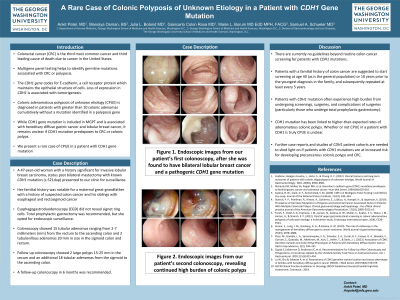Monday Poster Session
Category: Colon
P1629 - The Mysterious Case of Polyposis in CDH1
Monday, October 23, 2023
10:30 AM - 4:15 PM PT
Location: Exhibit Hall

Has Audio
.jpg)
Ankit Patel, MD
George Washington University
Washington, DC
Presenting Author(s)
Ankit Patel, MD1, Manolya Osman, BS2, Julia L. Boland, MD3, Giancarlo Colon Rosa, MD4, Samuel A. Schueler, MD4
1George Washington University, Washington, DC; 2George Washington University School of Medicine, Washington, DC; 3UCLA, Los Angeles, CA; 4George Washington University Hospital, Washington, DC
Introduction: Multigene panel testing (MGPT) may identify germline mutations associated with colorectal cancer (CRC). Colonic adenomatous polyposis of unknown etiology (CPUE) is diagnosed in patients with greater than 10 colonic adenomas cumulatively without a mutation identified in a polyposis gene. While CDH1 gene mutation is included in MGPT and is associated with hereditary diffuse gastric cancer and lobular breast cancer, it remains unclear if CDH1 mutation predisposes to CRC or colonic polyps. We present a rare case of CPUE in a patient with CDH1 mutation.
Case Description/Methods: Our patient is a 47-year-old female with invasive lobular breast carcinoma status post bilateral mastectomy. Prior MGPT showed only CDH1 mutation (c.521dup). Her maternal great-grandfather had suspected colon cancer. His siblings had esophageal and rectosigmoid cancer. Esophagogastroduodenoscopy (EGD) did not reveal signet ring cells. Total prophylactic gastrectomy was recommended, but she opted for endoscopic surveillance. Colonoscopy showed 15 tubular adenomas ranging from 2-7 millimeters (mm) from the rectum to the ascending colon and 2 tubulovillous adenomas 20 mm in size in the sigmoid colon and rectum. Follow-up colonoscopy showed 2 large polyps 15-25 mm in the cecum and an additional 18 tubular adenomas from the sigmoid to the ascending colon. A follow-up colonoscopy in 6 months was recommended.
Discussion: To our knowledge, there are only 5 described cases of patients with CDH1 mutation found to have greater than 20 colonic adenomatous polyps. The relationship between CDH1 mutation and risk of CRC or colonic polyps is unclear. In a subset of those who underwent colonoscopy in a prospective cohort study of 300 CDH1 mutation carriers, 56% of those below age 45 had polyps with the majority being pre-neoplastic. The authors postulated there could be an association between splice site and nonsense gene variants of CDH1 and colon polyps. Early truncated mutations of CDH-1 have also been associated with CRC.
Patients with CDH1 mutation are advised similarly to average risk individuals for colon cancer screening. Patients with CDH1 mutation and reported colonic polyposis are rare. However, CDH1 mutation has been linked to higher-than-expected rates of adenomatous colonic polyps. Whether or not CPUE in a patient with CDH1 is truly CPUE is unclear. We emphasize 1) the importance of CRC screening in patients with CDH1 mutation and 2) need for further study of the relationship between CDH1 and CRC.
Disclosures:
Ankit Patel, MD1, Manolya Osman, BS2, Julia L. Boland, MD3, Giancarlo Colon Rosa, MD4, Samuel A. Schueler, MD4. P1629 - The Mysterious Case of Polyposis in CDH1, ACG 2023 Annual Scientific Meeting Abstracts. Vancouver, BC, Canada: American College of Gastroenterology.
1George Washington University, Washington, DC; 2George Washington University School of Medicine, Washington, DC; 3UCLA, Los Angeles, CA; 4George Washington University Hospital, Washington, DC
Introduction: Multigene panel testing (MGPT) may identify germline mutations associated with colorectal cancer (CRC). Colonic adenomatous polyposis of unknown etiology (CPUE) is diagnosed in patients with greater than 10 colonic adenomas cumulatively without a mutation identified in a polyposis gene. While CDH1 gene mutation is included in MGPT and is associated with hereditary diffuse gastric cancer and lobular breast cancer, it remains unclear if CDH1 mutation predisposes to CRC or colonic polyps. We present a rare case of CPUE in a patient with CDH1 mutation.
Case Description/Methods: Our patient is a 47-year-old female with invasive lobular breast carcinoma status post bilateral mastectomy. Prior MGPT showed only CDH1 mutation (c.521dup). Her maternal great-grandfather had suspected colon cancer. His siblings had esophageal and rectosigmoid cancer. Esophagogastroduodenoscopy (EGD) did not reveal signet ring cells. Total prophylactic gastrectomy was recommended, but she opted for endoscopic surveillance. Colonoscopy showed 15 tubular adenomas ranging from 2-7 millimeters (mm) from the rectum to the ascending colon and 2 tubulovillous adenomas 20 mm in size in the sigmoid colon and rectum. Follow-up colonoscopy showed 2 large polyps 15-25 mm in the cecum and an additional 18 tubular adenomas from the sigmoid to the ascending colon. A follow-up colonoscopy in 6 months was recommended.
Discussion: To our knowledge, there are only 5 described cases of patients with CDH1 mutation found to have greater than 20 colonic adenomatous polyps. The relationship between CDH1 mutation and risk of CRC or colonic polyps is unclear. In a subset of those who underwent colonoscopy in a prospective cohort study of 300 CDH1 mutation carriers, 56% of those below age 45 had polyps with the majority being pre-neoplastic. The authors postulated there could be an association between splice site and nonsense gene variants of CDH1 and colon polyps. Early truncated mutations of CDH-1 have also been associated with CRC.
Patients with CDH1 mutation are advised similarly to average risk individuals for colon cancer screening. Patients with CDH1 mutation and reported colonic polyposis are rare. However, CDH1 mutation has been linked to higher-than-expected rates of adenomatous colonic polyps. Whether or not CPUE in a patient with CDH1 is truly CPUE is unclear. We emphasize 1) the importance of CRC screening in patients with CDH1 mutation and 2) need for further study of the relationship between CDH1 and CRC.
Disclosures:
Ankit Patel indicated no relevant financial relationships.
Manolya Osman indicated no relevant financial relationships.
Julia Boland indicated no relevant financial relationships.
Giancarlo Colon Rosa indicated no relevant financial relationships.
Samuel Schueler indicated no relevant financial relationships.
Ankit Patel, MD1, Manolya Osman, BS2, Julia L. Boland, MD3, Giancarlo Colon Rosa, MD4, Samuel A. Schueler, MD4. P1629 - The Mysterious Case of Polyposis in CDH1, ACG 2023 Annual Scientific Meeting Abstracts. Vancouver, BC, Canada: American College of Gastroenterology.

